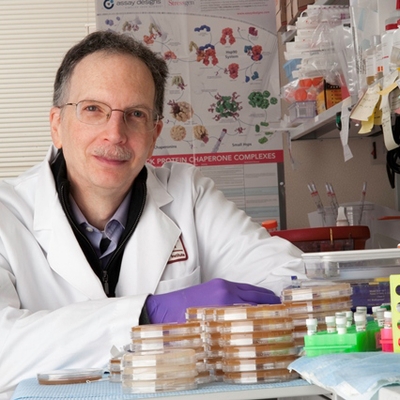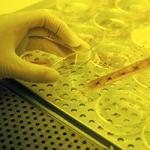
Research Topics
Molecularly Targeted Therapeutic Approaches to Modulate Cancer Cell Growth and Survival
The goal of this laboratory is to identify mechanism-based, molecularly targeted therapeutic approaches to modulate cancer cell growth and survival. An important facet of this goal is identification of novel intracellular targets for specific pharmacologic intervention. For the last several years, our research has been focused toward (1) understanding the biologic activity of chaperone proteins, particularly HSP90, in mediating signal transduction in cancer cells, and (2) promoting the translational development of HSP90 inhibitors as novel anti-cancer agents. Benzoquinone ansamycin antibiotics were isolated in the late 1970s and classified as tyrosine kinase inhibitors. However, we observed that these drugs did not function as classic tyrosine kinase inhibitors and we investigated their true mechanism of action.
Our discovery in 1993 that the HSP90 family of chaperone proteins was the predominant intracellular target of benzoquinone ansamycins led to a series of ongoing, interrelated studies in which we are (1) delineating the drug-protein interaction, (2) characterizing the sequelae of this interaction, and (3) identifying the components of the signal transduction machinery that are the secondary targets of this interaction. In addition, we are collaborating with the Developmental Therapeutics Program and CTEP, NCI, on clinical development of benzoquinone ansamycins, and we are currently participating in phase I and phase II testing of 2 HSP90 inhibitors in cancer patients. This research emphasizes the critical role of the HSP90 chaperone family in diverse signal transduction pathways and identifies the HSP90 family as novel targets for anticancer drug development. Although others have proposed, based on in vitro renaturation experiments, that HSP90 may act as a generally nonspecific chaperone, our findings support a different hypothesis; namely, that HSP90 function in vivo is highly specific and is regulated by interaction with unique accessory proteins.
In addition, we are the first to describe the importance of HSP90 in the function of mutated p53, Bcr-Abl, Raf, HIF-1alpha, and the receptor tyrosine kinase p185c-erbB2. In addition, we demonstrated the importance of the HSP90 homolog, GRP94, in the processing, trafficking, and stability of nascent erbB2 and other transmembrane tyrosine kinases. We have identified the ansamycin binding site on HSP90/GRP94 as a unique region in the amino terminal portion of the molecule. By studying many chemical derivatives of the basic benzoquinone ansamycin structure, we determined that biologic activity requires high affinity binding to HSP90/GRP94. We showed that this drug class disrupts HSP90/GRP94 interaction with several signal transduction proteins, resulting in destabilization and improper intracellular localization of the signal transducers. We have determined that, in addition to p185c-erbB2 and mutated p53, pp60v-src, c-raf-1, and HIF-1alpha proteins require HSP90 interaction for function. Protein destabilization triggered by benzoquinone ansamycins is mediated by ubiquitination followed by proteasome-dependent proteolysis. In the case of p53, drug treatment inactivates and destabilizes the mutated protein without affecting function of wild-type p53. Thus, cellular activity of multiple oncogene/proto-oncogene products depends on a common mechanism, making the HSP90 chaperone family an exciting new molecular target for anticancer drug development.
Our current studies include: (1) identification and characterization of other HSP90 client proteins; (2) identification and characterization of other small molecule antagonists of HSP90 that might be better suited for clinical use; and (3) investigation of the role of HSP90 in angiogenesis and metastasis. We are also participating in the design and implementation of several phase II clinical trials of HSP90 inhibitors alone or in combination with other agents for the experimental trreatment of mastocytosis, clear cell and papillary cell renal cancer, chronic myelogenous leukemia, and acute myelocytic leukemia.
Among our collaborators are Shiro Akinaga, Kyowa Hakko Kogyo Co., Ltd.; Yair Argon and M. Celeste Simon, University of Chicago; Frank Cuttitta, Zheng-gang Liu, Edward Sausville, and Jane Trepel, NIH; Randall Johnson, University of California, San Diego; Arthur Krieg, University of Iowa; Christopher Nichitta, Duke University; Moshe Oren and Yosef Yarden, Weizmann Institute; Neal Rosen, Memorial-Sloan Kettering Cancer Center, Charles Erlichman, Mayo Clinic, and David Toft, Mayo Clinic.
Biography
Selected Publications
- Zuehlke AD, Reidy M, Lin C, LaPointe P, Alsomairy S, Lee DJ, Rivera-Marquez GM, Beebe K, Prince T, Lee S, Trepel JB, Xu W, Johnson J, Masison D, Neckers L. An Hsp90 co-chaperone protein in yeast is functionally replaced by site-specific posttranslational modification in humans. Nat Commun. 2017;8:15328.
- Mollapour M, Bourboulia D, Beebe K, Woodford MR, Polier S, Hoang A, Chelluri R, Li Y, Guo A, Lee MJ, Fotooh-Abadi E, Khan S, Prince T, Miyajima N, Yoshida S, Tsutsumi S, Xu W, Panaretou B, Stetler-Stevenson WG, Bratslavsky G, Trepel JB, Prodromou C, Neckers L. Asymmetric Hsp90 N domain SUMOylation recruits Aha1 and ATP-competitive inhibitors. Mol Cell. 2014;53(2):317-29.
- Sourbier C, Scroggins BT, Ratnayake R, Prince TL, Lee S, Lee MJ, Nagy PL, Lee YH, Trepel JB, Beutler JA, Linehan WM, Neckers L. Englerin A stimulates PKCθ to inhibit insulin signaling and to simultaneously activate HSF1: pharmacologically induced synthetic lethality. Cancer Cell. 2013;23(2):228-37.
- Isaacs JS, Jung YJ, Mole DR, Lee S, Torres-Cabala C, Chung YL, Merino M, Trepel J, Zbar B, Toro J, Ratcliffe PJ, Linehan WM, Neckers L. HIF overexpression correlates with biallelic loss of fumarate hydratase in renal cancer: novel role of fumarate in regulation of HIF stability. Cancer Cell. 2005;8(2):143-53.
- Whitesell L, Mimnaugh EG, De Costa B, Myers CE, Neckers LM. Inhibition of heat shock protein HSP90-pp60v-src heteroprotein complex formation by benzoquinone ansamycins: essential role for stress proteins in oncogenic transformation. Proc Natl Acad Sci U S A. 1994;91(18):8324-8.
Related Scientific Focus Areas




Molecular Biology and Biochemistry
View additional Principal Investigators in Molecular Biology and Biochemistry
This page was last updated on Tuesday, February 20, 2024